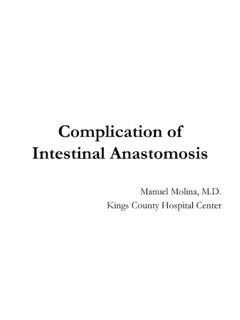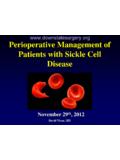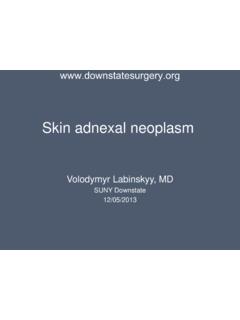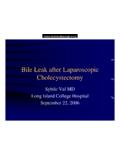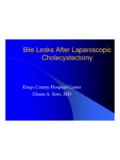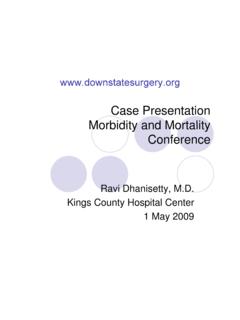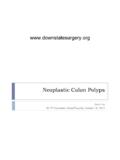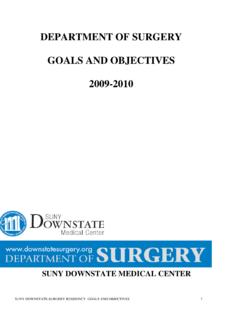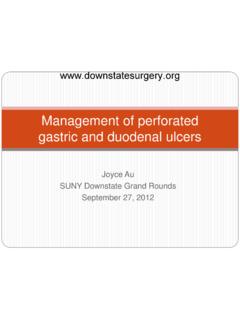Transcription of Laparoscopic Vs. Open Ventral Hernia Repair
1 Laparoscopic Vs. open Ventral Hernia Repair Irina Kovatch, MD Brooklyn VA Hospital Morbidity and Mortality January 12th, 2012 Presentation 63 yo M with symptomatic recurrent Ventral Hernia PMH: HTN, hypercholesterolemia PSH: primary Repair of Ventral Hernia in 2009, Repair of bilateral inguinal hernias in 1980s Meds: lipitor, lotril NKDA SH: former smoker (quit 25 years ago) PE: moderate size incisional Hernia , reducible BMI: after 81lb of intentional weight loss August 31, 2011 Laparoscopic approach - open Hasson technique Findings: ~10x15cm defect with omentum adherent to the sac Repair with Physiomesh (20x25cm)
2 And SecureStrap tacks Uneventful recovery and discharge home on POD 5 Outpatient follow-up as of Nov 8, 2011 no recurrence Wall hernias Common problem encountered by surgeons Despite the large volume of Hernia repairs performed, there remains no single best technique Many issues continue to influence the evolution of Ventral Hernia Repair methods increasing Laparoscopic experience influx of new mesh materials into the market changing patient population hernias Incisional - develop in up to 13% of patients who undergo a midline laparotomy (>28% if a wound infection develops)
3 Epigastric - frequent in obese individuals with attenuated tissues Umbilical - congenital in origin, but may occur later in life resulting from aging and increases in abdominal girth and pressure Repair of all of these defects frequently requires the use of a prosthetic material to achieve a lasting Repair for Repair Pain and discomfort that limit patient s ability to perform activities of daily life Risk for incarceration and strangulation of visceral organs Abdominal wall dysfunction that decreases quality of life Bulge in the abdominal wall that negatively affects appearance Repair Sutured closure alone is often inadequate to provide a
4 Durable Repair Defect <4 cm could be considered for primary closure unless predisposing factors for recurrence are present obesity, smoking, steroid usage, advanced age Defects >4 cm should always be repaired with a prosthesis unless an associated infection or other source of contamination is present Mesh products can be used either laparoscopically or in the open technique The open tissue Repair has recurrence rates of 25-50% without mesh, and 10-25% for inlay Repair with mesh Because of the high recurrence rate, the use of any mesh as a bridge is contraindicated in most instances (with exception of infection or open abdomen) Method Biomaterial is applied to the undersurface of the abdominal wall with strong fixation Provides the most durable Repair Minimum overlap of the fascial defect by the prosthesis should be 3 cm (4-5 cm in high-risk patients)
5 Application of the mesh in the open technique can be difficult, and transfascial sutures are required to adequately fixate the biomaterial hernias hernias larger than 15-18 cm, especially in lateral dimension, are increasingly being seen Component separation technique is increasingly being used in these cases For extreme cases, the application of progressive pneumoperitoneum to increase the intraabdominal cavity may aid in the final closure Approach Laparoscopic Repair of Ventral hernias is one of the fastest growing minimally invasive techniques Mesh is placed inside the peritoneal cavity with wide overlap of the Hernia defect Intraabdominal pressure acts to fix the mesh in place, and forces are dispersed over the entire abdominal wall of Laparoscopic Approach Laparoscopic approach allows for clear visualization of the abdominal wall.
6 Wide mesh coverage beyond the defect, and secure fixation to abdominal wall fascia Associated with a reduction in postoperative pain, decreased morbidity (esp. wound infections), shorter length of stay, decreased costs, and a quicker recovery time Recurrence rates with Laparoscopic approach average at ~5% Approach Limitations Leaves some patients with an abdominal wall bulge and persistent abdominal wall dysfunction Hernia defect is not closed, and the Hernia sac is left in place Postop seroma rate after elective Laparoscopic Ventral Hernia Repair 56% on clinical examination, 100% on US In 16% seromas persist for 6 weeks or longer, cause chronic pain.
7 Or become infected Some require therapeutic intervention Approach Technique Access: open Hasson technique, Veress needle, and direct Laparoscopic guidance Lysis of adhesions to the abdominal wall using blunt and sharp dissection Bleeding is controlled with pressure, hemoclips, or electrocautery Enterotomies may be repaired laparoscopically or through an open incision (delay mesh placement after 3-5 days on Abx) Approach Technique After the Hernia is completely reduced the defect is measured using spinal needle/umbilical tape/ruler Mesh should overlap all fascial defect margins by at least 5 cm Using a transfascial suture passer cardinal sutures are placed to anchor the mesh Tacks applied at 1cm interval at the outer edge of the mesh Tacks Absorbable tacking devices fix the product and disappear after 3 to 12 months The use of these products is appealing, but there are no long-term data on them If these are chosen.
8 It is best to place transfascial sutures to ensure a secure Repair until such a time as data prove them unnecessary Approach Defect Closure Primary closure may be performed prior to placement of the mesh in select patients (seldom feasible, but might result in decreased seroma formation) Placement of a mesh with dimensions similar to what would be placed in the absence of fascial closure is recommended If primary approximation is difficult, a bilateral Laparoscopic myofascial separation of components and advancement may be performed Closure of defect does not reduce recurrence rates and could result in more pain for the patient.
9 So most surgeons do not employ it Approach Defect Closure Primary closure may be performed prior to placement of the mesh in select patients Placement of a mesh with dimensions similar to what would be placed in the absence of fascial closure is recommended If primary approximation is difficult, a bilateral Laparoscopic myofascial separation of components and advancement may be performed Considerations: Enterotomy Extensive lysis of adhesions is often required Small bowel injuries can be catastrophic, especially if they are missed Nearly 20% of open adhesiolysis operations may result in inadvertent enterotomy Enterotomy has been reported in an average of 1% of patients in all large series of Laparoscopic Ventral Hernia Repair Considerations.
10 Enterotomy Management varies according to the type and extent of the injured intestine and the type of mesh available Small lacerations in the small intestine or bladder without contamination are not an absolute contraindication to mesh placement Placement of standard mesh in the presence of significant contamination is contraindicated Considerations: Enterotomy If fecal spillage is present and a prosthetic is required bowel should be repaired adhesiolysis completed patient placed on antibiotics delayed Hernia Repair is performed in 3-4 days if there are no signs of infection biologic or natural tissue may be used, although the long-term durability of these repairs is worse Considerations.

